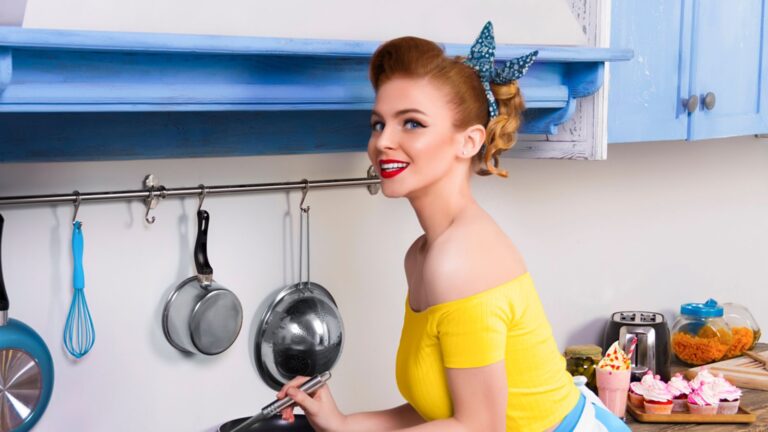If you experienced the 1960s, you likely recall many items that were commonplace in every household. However, with advancements in technology and changes in home décor, these items might now seem unusual by today’s standards. Here are 16 things that were found in almost every home during the ’60s.
Shag Carpeting

Apartment Therapy writes, “This cozy, high-pile rug style dominated design in the latter half of the 20th century despite being notoriously difficult to clean.” Shag carpeting was available in so many different colors and added both texture and comfort to a household. It really helped to reflect the era’s unique taste when it came to household furnishing.
Wood Kitchen Cabinets

It was common for natural materials such as wood to be used for kitchen cabinets. They offered warmth and character to a kitchen, and this reflects what a kitchen is all about. These wooden cabinets would often be complemented by Formica countertops to create a long-lasting kitchen.
Fondue Sets

Fondue sets were used when social gatherings took place at a person’s home. For example, the Financial Times writes, “The fondue party (it is never a fondue ‘dinner’) came of age in the mid-1960s.” These were popular for both chocolate and cheese recipes and are reflective of the era’s communal dining trend.
Corded Rotary Telephones

Corded rotary telephones were the main form of communication before the digital age and mobile phones took over. They featured a rotary dial, which was used to choose the telephone numbers. The phone was often put in a central location in the home, so everyone had easy access to it.
Canister Vacuum Cleaners

During the ‘60s, canister vacuum cleaners were essential for keeping homes clean and tidy. They were more portable compared to modern-day standing versions but would have been heavier. These types of canister vacuum cleaners show how home appliances have massively advanced throughout the decades.
Matching Kitchen Appliances

eHow writes, “The aesthetics of appliances became more pleasing during the 1960s. Homeowners could select from a range of colors, from butter yellow to sky blue, brown, or stainless steel.” This included items such as blenders, toasters, and mixers. People loved colorful appliances in the 1960s and saw them as aesthetically pleasing.
One ‘Full’ Bathroom

Having just one bathroom was seen as normal in mid-century houses. These kinds of bathrooms often included a bathtub and shower combination, giving a 2-in-1 option for many households. It reflected the practical living standards adopted in the ’60s, and these living arrangements still stand now.
Geometric Wallpaper

Geometric wallpaper became popular in many households. The ‘60s was a bold era, and many chose to reflect this through their interior design. Wallpaper patterns would range from simple shape designs to more complex patterns. This kind of wallpaper was seen as a way to add texture and visual interest to a home.
8-Track Tape Players

8-track tape players were the predecessors to cassettes and CD players. This is supported by Legacy Box, which writes, “8-track home players were introduced in 1966 and praised for their portability and affordability compared to vinyl.” They were a portable option that allowed people to have music on the go.
Console Record Players

These record players were the centerpiece of any home in the 1960s and a key component of music entertainment within the home. They were often found in decorative wooden cabinets that would then open to reveal the console record player. These players are reflective of the era’s love for vinyl music.
Matching Bedspread and Curtains

It was common in the ‘60s for a person’s bedspread to match their curtains. The types of patterns would also vary depending on the person’s bedroom. For example, some may choose floral patterns, while another person may go for something more geometrical. It shows the era’s attention to detail and interior design.
Exposed Spice Racks

Kinda Frugal writes, “In the 1960s, spice racks moved from behind cabinet doors to open display, adding visual interest to kitchens and reflecting a shift towards easy cooking practices.” Spices were displayed as a part of the décor and also created a more practical approach to cooking.
Grasscloth Wallpaper

Grasscloth wallpaper is textured wallpaper made from natural fibers. People in the ‘60s loved it for its organic look and feel. Even though it added both depth and texture to walls, it shows just how much trends have changed over the decades, as it’s something a modern-day household would never have.
Colorful Appliances

The 1960s were a time for color in the kitchen. Homes would feature brightly colored ovens, refrigerators, and other larger appliances, so don’t just think the bright colors were for small appliances. Popular colors included avocado green and harvest gold. It was a huge shift from the traditional white appliances households had previously seen.
Conversation Pits

It was common for households to have sunken seating areas in living rooms. For example, Domino writes, “Sunken living rooms offered a way to demarcate a separate sitting zone without having to put up walls, while also creating an intimate atmosphere for small groups.” Conversation pits helped to create an intimate way for people to gather and talk.
Real Wood Paneling

Real wood paneling was used extensively in interior decoration. This type of paneling adds warmth and a natural element to a home. It was commonly seen in areas of the home such as the basement, dens, and living rooms, as it added a more comfortable and cozy feel to rooms in the house.

